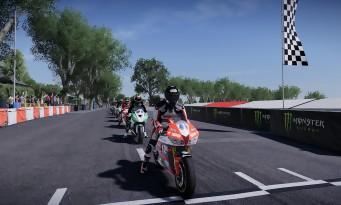 Almost every year since 1907, the Tourist Trophy (or TT for insiders) takes place in June, a motorcycle race contested on the country roads of the Isle of Man, a small rock lost in the Irish Sea. Extremely dangerous due to the total absence of release areas (more than 250 pilots were killed there), the route of the event winds over more than 60 km through the bucolic landscape of this rock, and requires competitors to memorize its 264 bends. As in real life, the game will therefore put us in the shoes of a pilot taking part in this event, and as much to tell you that succeeding in completing a lap of the Snaefell Mountain Course at an average speed of more than 215 Km/h, without falling and without our eyes or our brain begging for mercy, is a real challenge. After a short tutorial that teaches us the basics of motorcycle riding, the game drops us into the deep end of the craziest Irish road races.
Almost every year since 1907, the Tourist Trophy (or TT for insiders) takes place in June, a motorcycle race contested on the country roads of the Isle of Man, a small rock lost in the Irish Sea. Extremely dangerous due to the total absence of release areas (more than 250 pilots were killed there), the route of the event winds over more than 60 km through the bucolic landscape of this rock, and requires competitors to memorize its 264 bends. As in real life, the game will therefore put us in the shoes of a pilot taking part in this event, and as much to tell you that succeeding in completing a lap of the Snaefell Mountain Course at an average speed of more than 215 Km/h, without falling and without our eyes or our brain begging for mercy, is a real challenge. After a short tutorial that teaches us the basics of motorcycle riding, the game drops us into the deep end of the craziest Irish road races.
 For this new opus, Kylotonn has completely revised its career mode in order to offer us a slightly more authentic experience, and which is above all less centered on the famous Isle of Man route. For this, the Parisian developers now offer us to take part in a full season of events, with multiple individual events, and several stages counting for the Irish road racing championship. Now the TT is no longer the main activity, but the crowning glory of the season, where legends are made. But before you can claim glory, you will first have to prove yourself, as the Tourist Trophy is not open to tourists, contrary to what its name suggests.
For this new opus, Kylotonn has completely revised its career mode in order to offer us a slightly more authentic experience, and which is above all less centered on the famous Isle of Man route. For this, the Parisian developers now offer us to take part in a full season of events, with multiple individual events, and several stages counting for the Irish road racing championship. Now the TT is no longer the main activity, but the crowning glory of the season, where legends are made. But before you can claim glory, you will first have to prove yourself, as the Tourist Trophy is not open to tourists, contrary to what its name suggests.
TICKET TO RIDE
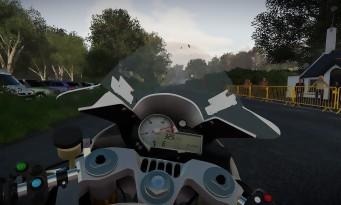 There are 3 ways to gain entry: win the Irish Road Race Championship, win the Junior TT (a 'beginner' version of the race, reserved for 600cc machines and contested over just 2 laps), or get enough signatures in medium-sized events in order to qualify for a wildcard. To achieve our goals, two possibilities are available to us. Either play it solo, and slam our savings into an original bike, then race alone. Either sign a juicy contract with one of the teams that came to approach us. A bit like in the WRC series, we'll only be interested in second-class teams at the start, and the more our reputation climbs, the more the big teams will win us over. Certain that no one would trust a beginner, so we invested all our PEL in a Honda CBR 600 RR, just before discovering that the offers of a handlebar were jostling at the gate.
There are 3 ways to gain entry: win the Irish Road Race Championship, win the Junior TT (a 'beginner' version of the race, reserved for 600cc machines and contested over just 2 laps), or get enough signatures in medium-sized events in order to qualify for a wildcard. To achieve our goals, two possibilities are available to us. Either play it solo, and slam our savings into an original bike, then race alone. Either sign a juicy contract with one of the teams that came to approach us. A bit like in the WRC series, we'll only be interested in second-class teams at the start, and the more our reputation climbs, the more the big teams will win us over. Certain that no one would trust a beginner, so we invested all our PEL in a Honda CBR 600 RR, just before discovering that the offers of a handlebar were jostling at the gate.
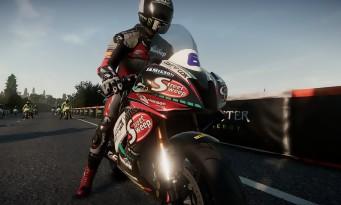 Oddly enough, we were able to sign our first contract straight away with MD Racing, a team with limited resources, but quite prestigious since it is run by Michael Dunlop (19 TT victories). A typical season has 20 days of competition, knowing that each time you can choose between several races of increasing difficulty. The harder the race, the juicier the reward, whether it's money, reputation, or perks. Indeed, to make our team progress, we will have to invest a hell of a lot to change the standard parts of our grinding wheels, in order to transform them into real cruise missiles. In addition, we will be able to have temporary power-ups (the famous perks - a great novelty of this episode) that we will also have to obtain during the races.
Oddly enough, we were able to sign our first contract straight away with MD Racing, a team with limited resources, but quite prestigious since it is run by Michael Dunlop (19 TT victories). A typical season has 20 days of competition, knowing that each time you can choose between several races of increasing difficulty. The harder the race, the juicier the reward, whether it's money, reputation, or perks. Indeed, to make our team progress, we will have to invest a hell of a lot to change the standard parts of our grinding wheels, in order to transform them into real cruise missiles. In addition, we will be able to have temporary power-ups (the famous perks - a great novelty of this episode) that we will also have to obtain during the races.
SCRUB THE FOOTPRINT
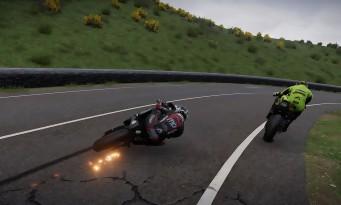 Basically, these are consumable cards that we will be able to play at the start of a race, and whose use is paid, but which provide great advantages. For example, against a few perk points and 500 pounds sterling, we will be able to benefit from electric blankets, which will prevent us from launching at more than 290 km/h in the straight line of Bray Hill with cold tires. We can also benefit from rubbers that degrade less quickly, reduced fuel consumption, or even ballast to make our bike comply with the minimum weight regulations. Progress in this career mode will therefore be subject to our level of control, but also to our strategic decisions. We can thus focus on the supersport category in order to obtain a high-performance machine quickly, or save as much as possible by contenting ourselves with places of honor in order to afford a 1000cc motorcycle, an entry ticket for the premier category of superbikes.
Basically, these are consumable cards that we will be able to play at the start of a race, and whose use is paid, but which provide great advantages. For example, against a few perk points and 500 pounds sterling, we will be able to benefit from electric blankets, which will prevent us from launching at more than 290 km/h in the straight line of Bray Hill with cold tires. We can also benefit from rubbers that degrade less quickly, reduced fuel consumption, or even ballast to make our bike comply with the minimum weight regulations. Progress in this career mode will therefore be subject to our level of control, but also to our strategic decisions. We can thus focus on the supersport category in order to obtain a high-performance machine quickly, or save as much as possible by contenting ourselves with places of honor in order to afford a 1000cc motorcycle, an entry ticket for the premier category of superbikes.
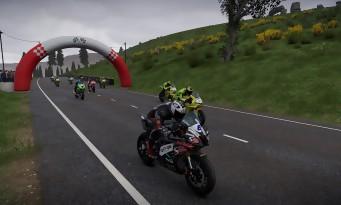 In our case, we preferred to play it small, and transform our CBR 600 into a real missile, which took us about 2 seasons. Overall, the calendar is quite well done, and offers a nice variety of circuits and destinations with 9 tracks for England, 8 for Ireland and the 12 sections of the Snaeffel Mountain Course. If the number may seem low compared to other games, you should know that these tracks are particularly long, and the monotony did not settle on the 15 hours of play spent wringing the throttle. In order not to lose the novices, Kylotonn has classified the parts by category (from the most useless to the most efficient), which makes it easy to increase the performance of our motorcycle.
In our case, we preferred to play it small, and transform our CBR 600 into a real missile, which took us about 2 seasons. Overall, the calendar is quite well done, and offers a nice variety of circuits and destinations with 9 tracks for England, 8 for Ireland and the 12 sections of the Snaeffel Mountain Course. If the number may seem low compared to other games, you should know that these tracks are particularly long, and the monotony did not settle on the 15 hours of play spent wringing the throttle. In order not to lose the novices, Kylotonn has classified the parts by category (from the most useless to the most efficient), which makes it easy to increase the performance of our motorcycle.
Moreover, it should be noted that the modeling of mounts has clearly progressed, even if their number is not very impressive.
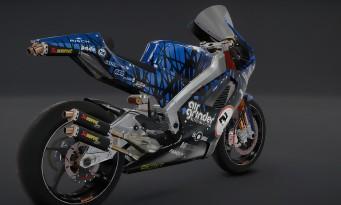 Be careful, not to abuse, each motorcycle must have a minimum weight, which prevents you from mounting all the best parts on your bike. Choices will therefore have to be made, and everything will be a matter of compromise. Moreover, the quality components will be essential in order to allow us to adjust our motorcycle, which is impossible to do on the original elements. A racing transmission will allow the gearbox ratios to be modified, racing suspensions will be fully configurable, while a competition engine will allow the desired level of engine braking to be adjusted. Of course, not all parts are immediately available, and it will often take specific actions to unlock them. Some components will be obtained by completing the objectives with a stable, others by ranking well in the TT, and finally the last ones will have to be obtained through specific events.
Be careful, not to abuse, each motorcycle must have a minimum weight, which prevents you from mounting all the best parts on your bike. Choices will therefore have to be made, and everything will be a matter of compromise. Moreover, the quality components will be essential in order to allow us to adjust our motorcycle, which is impossible to do on the original elements. A racing transmission will allow the gearbox ratios to be modified, racing suspensions will be fully configurable, while a competition engine will allow the desired level of engine braking to be adjusted. Of course, not all parts are immediately available, and it will often take specific actions to unlock them. Some components will be obtained by completing the objectives with a stable, others by ranking well in the TT, and finally the last ones will have to be obtained through specific events.
 The game now hosts a Challenge mode that will allow us to drive freely on the Irish map of the game, and to perform certain very specific actions, such as breaking acceleration records, top speed, etc. In addition, over time, specific events will appear in various places to test us on the handlebars of various machines, which allows us to unlock mechanical parts, but also liveries to decorate our wheels. Moreover, it should be noted that the modeling of mounts has clearly progressed, even if their number is not very impressive. We have to make do with 5 supersports, 8 superbikes (including the attractive Suter MMX500 2-stroke) and 4 classics from olden times. The advantage of this limited selection is that each machine distills its own driving sensations.
The game now hosts a Challenge mode that will allow us to drive freely on the Irish map of the game, and to perform certain very specific actions, such as breaking acceleration records, top speed, etc. In addition, over time, specific events will appear in various places to test us on the handlebars of various machines, which allows us to unlock mechanical parts, but also liveries to decorate our wheels. Moreover, it should be noted that the modeling of mounts has clearly progressed, even if their number is not very impressive. We have to make do with 5 supersports, 8 superbikes (including the attractive Suter MMX500 2-stroke) and 4 classics from olden times. The advantage of this limited selection is that each machine distills its own driving sensations.
KILL ALL TIRES
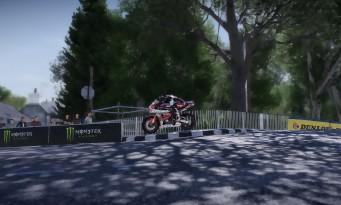 Where the game has clearly progressed is in its gameplay. The physics have been greatly improved, and the behavior of the machines is now much more realistic. It's over with the feeling of floating that we could have before, and we now understand each time the cause of our falls. Of course, it will be necessary to remove all driving aids to be able to realize the extent of the progress made, especially in terms of tire grip. These are now subject to wear that will greatly depend on our style of riding, and the temperature of the envelopes. Depending on the outside temperature, and the constraints to which they are subjected, the tires will heat up, and sometimes even overheat, which affects their efficiency. Similarly, the brakes or the motor will be linked to thermal stresses capable of causing them to fail.
Where the game has clearly progressed is in its gameplay. The physics have been greatly improved, and the behavior of the machines is now much more realistic. It's over with the feeling of floating that we could have before, and we now understand each time the cause of our falls. Of course, it will be necessary to remove all driving aids to be able to realize the extent of the progress made, especially in terms of tire grip. These are now subject to wear that will greatly depend on our style of riding, and the temperature of the envelopes. Depending on the outside temperature, and the constraints to which they are subjected, the tires will heat up, and sometimes even overheat, which affects their efficiency. Similarly, the brakes or the motor will be linked to thermal stresses capable of causing them to fail.
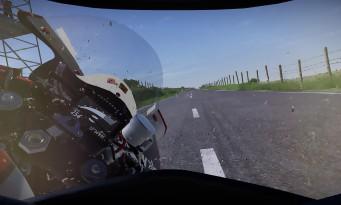 Suffice to say that when the tires reach 130°c, not only do they wear out incredibly quickly, but the rubber is so soft that it only offers minimal grip. If we can curb some problems with a better radiator, or a larger brake kit, it is impossible to modify the tires, and only the dexterity of the player can make the difference. The improvement in physics is also felt on the suspensions and their work. Now the bike crashes in the compressions, while the shock absorbers try to keep the wheels on the ground despite the irregularities of the road. In this sense, we could say that this new opus brings significantly more verticality to the gameplay, since each crest will send the front wheel in the air, while each bump can make the machine and its pilot jump out of the trajectory. It will therefore be necessary to work a lot with the left stick (which controls the weight of the pilot) to take the turns, but also to pitch up the machine, or try to press the front wheel on the tarmac.
Suffice to say that when the tires reach 130°c, not only do they wear out incredibly quickly, but the rubber is so soft that it only offers minimal grip. If we can curb some problems with a better radiator, or a larger brake kit, it is impossible to modify the tires, and only the dexterity of the player can make the difference. The improvement in physics is also felt on the suspensions and their work. Now the bike crashes in the compressions, while the shock absorbers try to keep the wheels on the ground despite the irregularities of the road. In this sense, we could say that this new opus brings significantly more verticality to the gameplay, since each crest will send the front wheel in the air, while each bump can make the machine and its pilot jump out of the trajectory. It will therefore be necessary to work a lot with the left stick (which controls the weight of the pilot) to take the turns, but also to pitch up the machine, or try to press the front wheel on the tarmac.
Do not panic for novices, if victory remains an outcome, know that the many piloting aids make it very easy to apprehend the cars
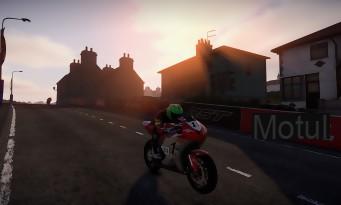 The immersion allowed by this gameplay in clear progression is also reinforced by the improvement of the sound (motors and echo mainly) and graphics. Kylotonn's new graphics engine offers us a nice display distance when we approach the mountain section, flocks of mosquitoes that dirty our visor over the laps, and superb light effects, when the sun breaks through the canopy. on the Bray Hill Straight. Moreover, depending on the time at which we will attack the race, the sun can also become devilishly blinding, forcing the player to know the slightest bend by heart in order to be able to go full throttle, without letting go of the gas. It must be said that succeeding in completing a lap of the Snaeffel Mountain Course without crashing is a real test in itself, especially on the handlebars of superbikes which can exceed 330Km/h.
The immersion allowed by this gameplay in clear progression is also reinforced by the improvement of the sound (motors and echo mainly) and graphics. Kylotonn's new graphics engine offers us a nice display distance when we approach the mountain section, flocks of mosquitoes that dirty our visor over the laps, and superb light effects, when the sun breaks through the canopy. on the Bray Hill Straight. Moreover, depending on the time at which we will attack the race, the sun can also become devilishly blinding, forcing the player to know the slightest bend by heart in order to be able to go full throttle, without letting go of the gas. It must be said that succeeding in completing a lap of the Snaeffel Mountain Course without crashing is a real test in itself, especially on the handlebars of superbikes which can exceed 330Km/h.
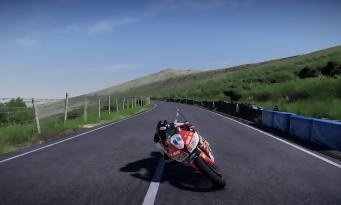 With an AI that has become devilishly faster, and with more believable behavior (even if we still see bizarre accidents, especially in very low speed corners including Ramsey), the simple fact of cutting the throttle in the Ballagarey corner translates into more than a second lost on the pursuers. However, as in the previous opus, the fall is still not allowed, since no rewind system exists, while the respawn is particularly long, in order to punish the pilot who would normally have lost his life. Do not panic for novices, if victory remains an outcome, know that the many piloting aids make it very easy to apprehend the cars, even if they will have to be deactivated to grab the last seconds which make the difference between the first places. from the podium.
With an AI that has become devilishly faster, and with more believable behavior (even if we still see bizarre accidents, especially in very low speed corners including Ramsey), the simple fact of cutting the throttle in the Ballagarey corner translates into more than a second lost on the pursuers. However, as in the previous opus, the fall is still not allowed, since no rewind system exists, while the respawn is particularly long, in order to punish the pilot who would normally have lost his life. Do not panic for novices, if victory remains an outcome, know that the many piloting aids make it very easy to apprehend the cars, even if they will have to be deactivated to grab the last seconds which make the difference between the first places. from the podium.


























